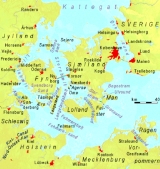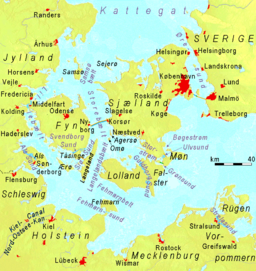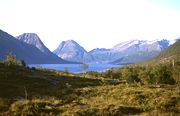
Danish straits
Encyclopedia

Baltic Sea
The Baltic Sea is a brackish mediterranean sea located in Northern Europe, from 53°N to 66°N latitude and from 20°E to 26°E longitude. It is bounded by the Scandinavian Peninsula, the mainland of Europe, and the Danish islands. It drains into the Kattegat by way of the Øresund, the Great Belt and...
to the North Sea
North Sea
In the southwest, beyond the Straits of Dover, the North Sea becomes the English Channel connecting to the Atlantic Ocean. In the east, it connects to the Baltic Sea via the Skagerrak and Kattegat, narrow straits that separate Denmark from Norway and Sweden respectively...
through the Kattegat
Kattegat
The Kattegat , or Kattegatt is a sea area bounded by the Jutland peninsula and the Straits islands of Denmark on the west and south, and the provinces of Västergötland, Scania, Halland and Bohuslän in Sweden on the east. The Baltic Sea drains into the Kattegat through the Øresund and the Danish...
and Skagerrak
Skagerrak
The Skagerrak is a strait running between Norway and the southwest coast of Sweden and the Jutland peninsula of Denmark, connecting the North Sea and the Kattegat sea area, which leads to the Baltic Sea.-Name:...
. They transect Denmark, and are not to be confused with the Denmark Strait
Denmark Strait
The Denmark Strait or Greenland Strait |Sound]]) is an oceanic strait between Greenland and Iceland...
between Greenland
Greenland
Greenland is an autonomous country within the Kingdom of Denmark, located between the Arctic and Atlantic Oceans, east of the Canadian Arctic Archipelago. Though physiographically a part of the continent of North America, Greenland has been politically and culturally associated with Europe for...
and Iceland
Iceland
Iceland , described as the Republic of Iceland, is a Nordic and European island country in the North Atlantic Ocean, on the Mid-Atlantic Ridge. Iceland also refers to the main island of the country, which contains almost all the population and almost all the land area. The country has a population...
. The three main passages are:
- Great BeltGreat BeltThe Great Belt is a strait between the main Danish islands of Zealand and Funen . Effectively dividing Denmark in two, the Belt was served by the Great Belt ferries from the late 19th century until the islands were connected by the Great Belt Fixed Link in 1997–98.-Geography:The Great Belt is the...
, Danish: Storebælt - Little BeltLittle BeltThe Little Belt is a strait between the Danish island of Funen and the Jutland Peninsula.The belt is about 50 km long and 800m to 28 km wide, the maximum depth is approximately 75 m, and contains numerous small Danish islands....
, Danish: Lillebælt - OresundOresundThe Sound , is the strait that separates the Danish island Zealand from the southern Swedish province of Scania. Its width is just at the narrowest point between Helsingør, Denmark, and Helsingborg, Sweden...
, Danish: Øresund (Swedish: Öresund)
By closer view there are five straits named belt (Danish: Bælt), the only ones in the world and several straits named sound (Danish, Swedish and German: sund). Where an island is situated between a belt and a sound, typically the broader strait is called belt and the more narrow one is the sound:
- Als:
- separated from the continent by Alssund
- separated from FynFYNProto-oncogene tyrosine-protein kinase Fyn is an enzyme that in humans is encoded by the FYN gene.This gene is a member of the protein-tyrosine kinase oncogene family. It encodes a membrane-associated tyrosine kinase that has been implicated in the control of cell growth...
the southern part of the Little Belt, an area referred to in German (but not Danish) as Alsenbelt
- FehmarnFehmarnFehmarn is an island and - since 2003 - a town on this island in the Baltic Sea, off the eastern coast of Schleswig-Holstein, Germany, and ca. 18 kilometers south of the Danish island of Lolland...
- separated from the Continent by Fehmarnsund, also Femersund
- separated from LollandLollandLolland is the fourth largest island of Denmark, with an area of 1,243 square kilometers . Located in the Baltic sea, it is part of Region Sjælland...
by Fehmarnbelt (German) / Femerbelt (PlattLow GermanLow German or Low Saxon is an Ingvaeonic West Germanic language spoken mainly in northern Germany and the eastern part of the Netherlands...
) / Femernbælt (former spelling: Femer Bælt)

- LangelandLangelandLangeland is a Danish island located between the Great Belt and Bay of Kiel. The island measures 285 km² and, as of 1 January 2010, has a population of 13,277. The island produces grain and is known as a recreational area. A bridge connects it to Tåsinge via Siø - a small island with a...
:- separated from TåsingeTåsingeTåsinge is a Danish island south of Funen, at Svendborg. The island covers an area of 70 km² and has 6,111 inhabitants.Tåsinge was once called Thorsinge or Thorsenge, which in the Danish means "Thor's Bed" or "Thor's Meadow"...
Island by Siø Sund (Tåsinge itself is separated from Fyn by Svendborg Sund) - separated from Lolland by Langelandsbælt, the southern part of Great Belt
- separated from Tåsinge
- LollandLollandLolland is the fourth largest island of Denmark, with an area of 1,243 square kilometers . Located in the Baltic sea, it is part of Region Sjælland...
:- separated from FalsterFalsterFalster is an island in south-eastern Denmark with an area of 514 km² and 43,398 inhabitants as of 1 January 2010. Located in the Baltic sea, it is part of Region Sjælland and is administered by Guldborgsund Municipality...
Island by Guldborgsund (Falster itself is separated from Zealand by StorstrømmenStorstrømmenStorstrømmen is a strait in Denmark separating the island Falster from the island Zealand. Its maximum depth is approximately 36 metres and the length is around 10 km. Smålandsfarvandet sound is situated to the west and Grønsund lies to the east. Storstrøm Bridge crosses Storstrømmen between...
Strait) - separated from Langeland by Langelandsbælt
- separated from Fehmarn by Femernbælt, which is the common continuation of Great Belt–Langelandsbælt and Little Belt
- separated from Falster
- Zealand (Danish: Sjælland)
- separated from ScandinaviaScandinaviaScandinavia is a cultural, historical and ethno-linguistic region in northern Europe that includes the three kingdoms of Denmark, Norway and Sweden, characterized by their common ethno-cultural heritage and language. Modern Norway and Sweden proper are situated on the Scandinavian Peninsula,...
Peninsula of the continent by Øresund (Danish) / Öresund (Swedish) - separated from Fyn Island by the Great BeltGreat BeltThe Great Belt is a strait between the main Danish islands of Zealand and Funen . Effectively dividing Denmark in two, the Belt was served by the Great Belt ferries from the late 19th century until the islands were connected by the Great Belt Fixed Link in 1997–98.-Geography:The Great Belt is the...
- separated from Scandinavia
Etymology and general use of Sound / Sund

Germanic languages
The Germanic languages constitute a sub-branch of the Indo-European language family. The common ancestor of all of the languages in this branch is called Proto-Germanic , which was spoken in approximately the mid-1st millennium BC in Iron Age northern Europe...
word "sound" has the same root as the verb "to sunder" in the meaning of to separate. In Swedish language
Swedish language
Swedish is a North Germanic language, spoken by approximately 10 million people, predominantly in Sweden and parts of Finland, especially along its coast and on the Åland islands. It is largely mutually intelligible with Norwegian and Danish...
any strait is called "Sund". In Norway hundreds of narrow straits separating islands and combining Fjords or outer parts of Fjords are named "Sund". Another explanation derives Sound from an ancient verb "sund" in the meaning of to swim. That way a sound is a swimmable strait.
With the denomination of fjords and other bays in North America (Prince William Sound
Prince William Sound
Prince William Sound is a sound off the Gulf of Alaska on the south coast of the U.S. state of Alaska. It is located on the east side of the Kenai Peninsula. Its largest port is Valdez, at the southern terminus of the Trans-Alaska Pipeline System...
) and New Zealand the European meaning of the word has been lost.
The Germanic word "sound" is not related to the Romance
Romance languages
The Romance languages are a branch of the Indo-European language family, more precisely of the Italic languages subfamily, comprising all the languages that descend from Vulgar Latin, the language of ancient Rome...
originated word "sound", which has developed from the Latin sonus.
See also
- Kiel CanalKiel CanalThe Kiel Canal , known as the Kaiser-Wilhelm-Kanal until 1948, is a long canal in the German state of Schleswig-Holstein.The canal links the North Sea at Brunsbüttel to the Baltic Sea at Kiel-Holtenau. An average of is saved by using the Kiel Canal instead of going around the Jutland Peninsula....
- List of islands of Denmark

